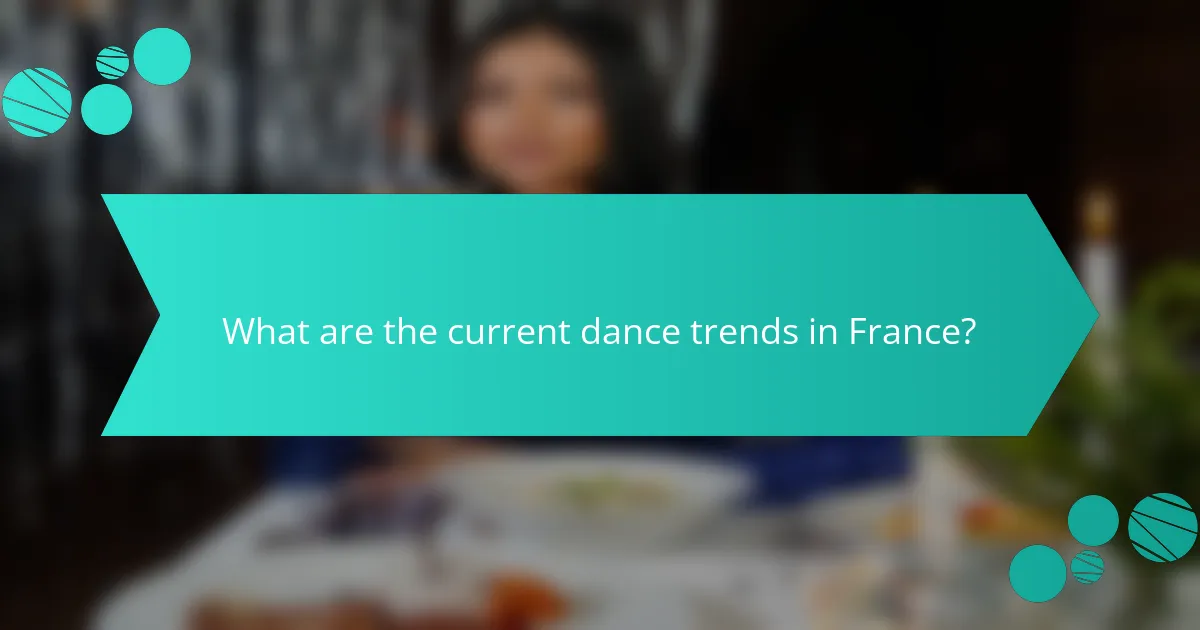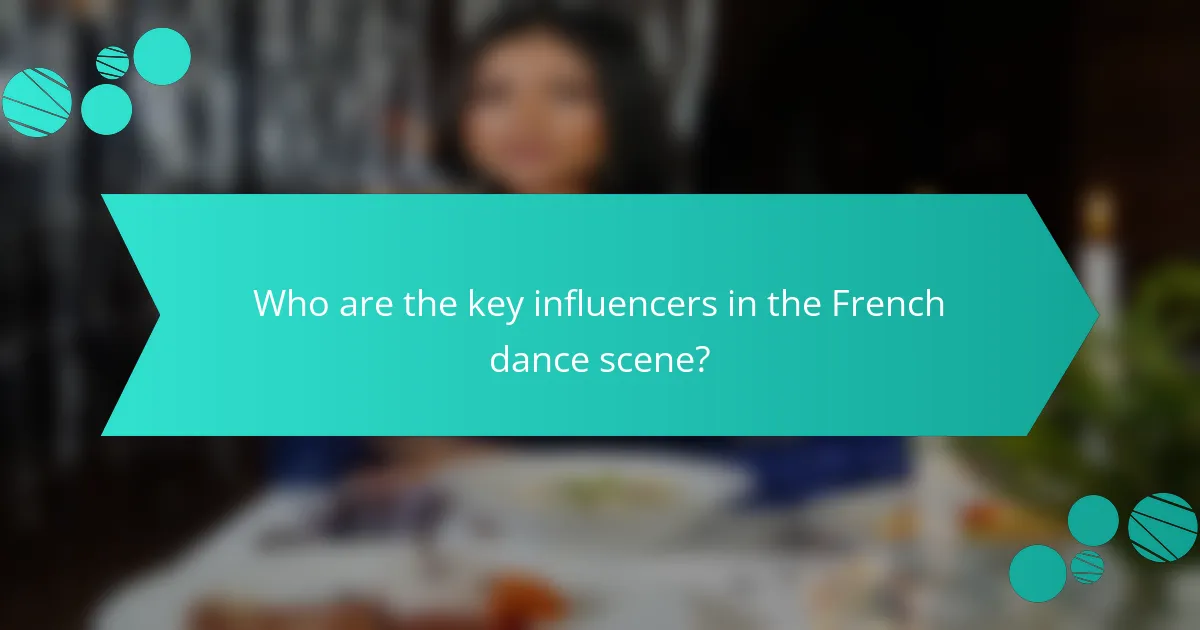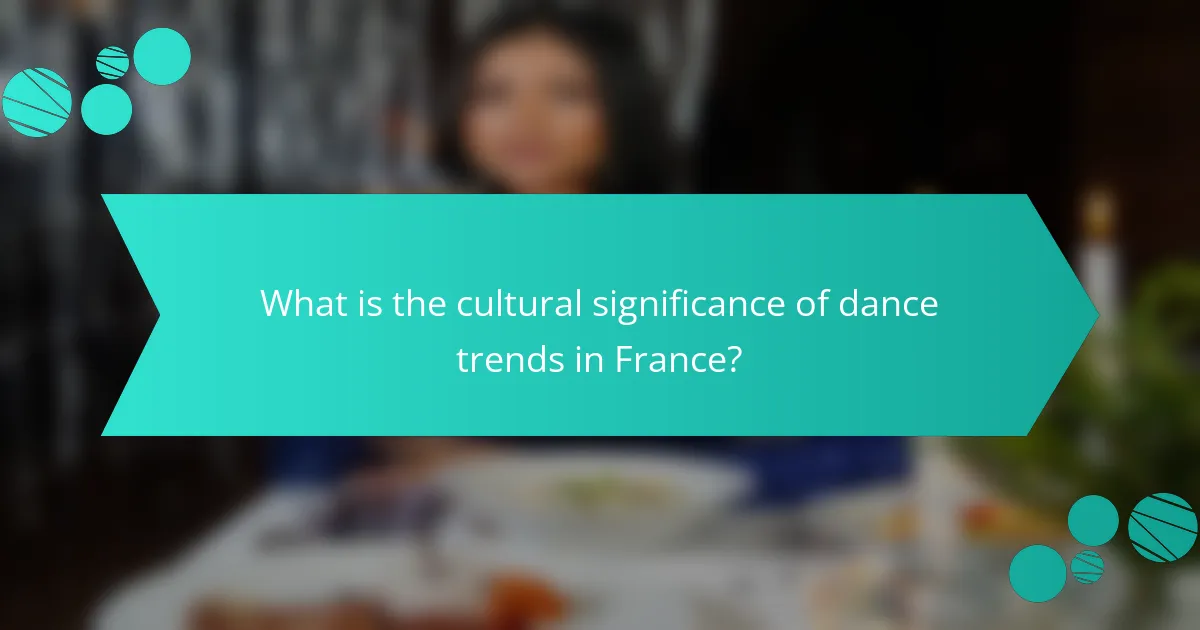The article focuses on the current dance trends in France, highlighting key styles such as hip-hop, contemporary dance, and traditional folk dances. Hip-hop remains particularly popular among youth, while contemporary dance is increasingly featured in performance art venues and festivals. Influential figures in the French dance scene, including choreographers like Angelin Preljocaj and Benjamin Millepied, play significant roles in shaping these trends. The article also examines the cultural significance of dance in France, noting how it reflects societal values, promotes social cohesion, and preserves heritage through various community events and festivals. Overall, the landscape of dance in France is characterized by its dynamic evolution and diverse cultural influences.

What are the current dance trends in France?
Current dance trends in France include hip-hop, contemporary, and traditional folk dances. Hip-hop remains highly popular, especially among youth. Contemporary dance is gaining traction in performance art spaces and festivals. Traditional folk dances are being revitalized through cultural festivals and community events. Dance challenges on social media platforms like TikTok influence these trends significantly. The Paris dance scene showcases a blend of styles, reflecting diverse cultural influences. Dance schools are adapting curricula to include these trending styles. Overall, the landscape of dance in France is dynamic and continually evolving.
How have contemporary influences shaped these trends?
Contemporary influences have significantly shaped French dance trends through globalization and social media. Globalization has introduced diverse dance styles from around the world. This exposure encourages fusion and innovation within traditional French dance forms. Social media platforms amplify visibility for emerging dancers and choreographers. They provide a space for sharing performances and tutorials, enhancing community engagement. Influencers on these platforms often set trends by showcasing unique interpretations of dance. Events like dance challenges further popularize specific styles, creating viral moments. The interaction between traditional and contemporary styles reflects the evolving cultural landscape in France.
What role do social media platforms play in promoting dance fads?
Social media platforms play a crucial role in promoting dance fads. They provide a space for dancers to showcase their skills and creativity. Platforms like TikTok and Instagram enable viral challenges that encourage participation. These challenges often lead to widespread adoption of specific dance moves. Influencers and dancers can reach large audiences quickly. This rapid dissemination fosters trends that can become global phenomena. According to a study by the Pew Research Center, 69% of adults in the U.S. use social media, highlighting its significant reach. The engagement on these platforms creates a community around dance fads, further amplifying their popularity.
How do cultural events influence dance trends in France?
Cultural events significantly influence dance trends in France. Festivals, such as the Festival de Danse in Cannes, showcase diverse styles. These events attract both local and international talent. They promote the exchange of ideas and techniques among dancers. Additionally, cultural celebrations like Bastille Day inspire patriotic dance forms. The visibility of dance in public events encourages participation and innovation. Historical events, such as the French Revolution, also shaped dance styles reflecting societal changes. Overall, cultural events serve as catalysts for evolving dance trends in France.
What styles of dance are currently popular in France?
Contemporary dance and hip-hop are currently popular styles of dance in France. Contemporary dance emphasizes expression and creativity, often blending various techniques. Hip-hop, with its roots in urban culture, showcases energetic movements and is widely performed in street dance battles. Ballet remains a significant influence, especially in classical training. Additionally, styles like salsa and tango enjoy popularity in social dance scenes. These trends reflect France’s diverse cultural landscape and the influence of global dance movements.
What are the characteristics of these popular dance styles?
Popular dance styles exhibit distinct characteristics. Ballet is known for its grace, precision, and structured technique. It emphasizes formalized movements and positions. Hip-hop is characterized by its energetic and rhythmic style. It includes various forms like breaking and locking. Contemporary dance blends elements of ballet and modern dance. It focuses on fluidity and expression of emotions. Salsa is marked by its lively, fast-paced movements and partner work. It incorporates spins and intricate footwork. Each style reflects cultural influences and artistic expression.
How do traditional French dances compare to modern styles?
Traditional French dances emphasize structured formations and historical context. These dances often reflect regional customs and folklore. Examples include the Bourrée and the Gavotte, which have distinct steps and rhythms. Modern styles, such as hip-hop and contemporary dance, prioritize individual expression and improvisation. These styles often incorporate diverse influences from global dance trends. Traditional dances are typically performed in groups, while modern styles can be solo or group-based. The music accompanying traditional dances is often folk or classical, whereas modern styles use a variety of genres, including pop and electronic. This evolution shows a shift from communal heritage to personal expression in dance.

Who are the key influencers in the French dance scene?
Key influencers in the French dance scene include choreographers and dancers such as Angelin Preljocaj, who is renowned for contemporary ballet. Another significant figure is Benjamin Millepied, known for his work with the Paris Opera Ballet and his innovative choreography. Additionally, the iconic dance company, Compagnie Käfig, led by Mourad Merzouki, highlights urban dance styles and cultural fusion. These individuals and groups shape the landscape of dance in France through their unique styles and contributions to choreography. Their influence can be seen in both traditional and contemporary performances across the country.
What impact do dance influencers have on trends?
Dance influencers significantly shape trends in the dance community. They introduce new styles, techniques, and choreography through social media platforms. Their content often goes viral, prompting widespread participation in specific dance challenges. For example, TikTok has seen numerous dance trends emerge from influencer choreography. These trends can lead to increased visibility for certain music genres and artists. Additionally, influencers often collaborate with brands, further promoting dance-related products. Their impact is measurable through engagement metrics, such as likes, shares, and comments on their posts. Overall, dance influencers play a crucial role in the evolution of dance culture and trends.
Who are the most prominent dance influencers in France today?
The most prominent dance influencers in France today include Marion Motin, who is known for her work in contemporary dance and choreography. Another key figure is Sofia Boutella, recognized for her contributions to both dance and film. Additionally, the duo Les Twins, comprised of Laurent and Larry Bourgeois, are influential in the hip-hop dance scene. These influencers have gained significant recognition through social media platforms and performances. Their unique styles and collaborations have helped shape the current dance landscape in France.
How do these influencers engage with their audience?
Influencers engage with their audience through interactive content and social media platforms. They utilize live streaming to showcase dance techniques and trends. This real-time interaction fosters a sense of community among followers. Influencers also encourage audience participation through challenges and hashtags. They share user-generated content to highlight their followers’ skills. Engaging storytelling in posts enhances relatability and connection. Regular Q&A sessions allow influencers to address audience queries directly. These methods have been shown to increase audience loyalty and engagement metrics significantly.
What platforms do these influencers utilize?
Influencers in the French dance scene primarily utilize social media platforms. These platforms include Instagram, TikTok, and YouTube. Instagram allows for visual storytelling through photos and short videos. TikTok is popular for sharing dance challenges and trends. YouTube serves as a platform for longer dance tutorials and performances. These platforms enable influencers to reach wider audiences and engage with fans effectively. The choice of platform often depends on the type of content they create and the audience they wish to target.
How does Instagram shape the perception of dance trends?
Instagram shapes the perception of dance trends by providing a platform for visibility and engagement. The platform allows users to share short video clips showcasing dance moves. This visual format encourages creativity and trend replication among followers. Influencers and dancers often use popular hashtags to increase discoverability. Trends can spread rapidly through viral challenges and collaborations. Statistics show that dance-related content receives high engagement rates on Instagram. According to a 2021 report, dance challenges accounted for over 30% of viral content on the platform. This engagement influences what styles become popular and mainstream. Thus, Instagram plays a crucial role in shaping contemporary dance culture.
What role does YouTube play in dance tutorials and showcases?
YouTube serves as a primary platform for dance tutorials and showcases. It enables dancers to access a vast array of instructional videos. Users can learn various dance styles through step-by-step guidance. Many professional dancers and choreographers share their expertise on the platform. This accessibility has democratized dance education, allowing anyone to learn from home. YouTube also hosts dance showcases, where performers display their skills. These showcases help promote emerging talent and diverse dance forms. The platform’s global reach fosters a community of dance enthusiasts and creators.

What is the cultural significance of dance trends in France?
Dance trends in France hold significant cultural importance as they reflect societal values and shifts. These trends often serve as a form of expression and identity for various communities. For instance, the rise of hip-hop dance in urban areas highlights the influence of multiculturalism in French society. Additionally, traditional dances are preserved and celebrated during festivals, showcasing France’s rich heritage. Dance trends also promote social cohesion, bringing people together through shared experiences. Historical events, such as the French Revolution, have influenced dance styles, integrating political and social commentary into performances. Overall, dance trends in France are a dynamic representation of its evolving culture.
How do dance trends reflect societal changes?
Dance trends reflect societal changes by embodying cultural values and social movements. For instance, the rise of hip-hop dance coincided with urban youth culture and issues of identity and resistance. Similarly, dances that emerged during the feminist movement highlighted women’s empowerment and social equality. Historical events, such as the civil rights movement, influenced dance styles that promoted unity and activism. The popularity of social media has accelerated the spread of trends, showcasing diverse voices and experiences. Overall, dance serves as a mirror, revealing shifts in societal attitudes, norms, and collective consciousness.
What messages do current dance trends convey about French culture?
Current dance trends convey messages of diversity and inclusivity in French culture. They reflect the blending of traditional and contemporary styles. Popular dance forms, such as hip-hop and contemporary, showcase multicultural influences. These trends highlight France’s evolving identity as a hub for artistic expression. Dance events often celebrate social issues, promoting unity and awareness. The rise of street dance emphasizes grassroots creativity and community engagement. Additionally, collaborations among dancers from different backgrounds illustrate cultural exchange. Overall, contemporary dance trends signify a dynamic and interconnected French cultural landscape.
How do dance trends foster community and identity?
Dance trends foster community and identity by providing shared experiences and cultural expressions. They create spaces for individuals to connect through movement and rhythm. Participation in dance trends allows people to express their backgrounds and personal stories. Social media amplifies these trends, enabling wider participation and community building. Events like dance battles and flash mobs encourage collaboration and unity among diverse groups. Studies show that group dance activities enhance social bonding and collective identity. For instance, research indicates that dance serves as a form of social cohesion in various cultures. This shared engagement in dance trends strengthens communal ties and fosters a sense of belonging.
What historical context influences modern French dance trends?
Modern French dance trends are influenced by historical movements such as ballet, contemporary dance, and street dance. The origins of ballet in the 16th century set a foundation for structured movement and technique. The French Revolution in the late 18th century brought social change, influencing dance as a form of expression. The emergence of modern dance in the 20th century introduced new styles and freedom of movement. French choreographers like Martha Graham and Merce Cunningham impacted the evolution of contemporary dance in France. Additionally, the rise of hip-hop culture in the 1980s introduced street dance forms, blending urban influences with traditional techniques. These historical contexts create a diverse landscape for modern French dance, reflecting cultural shifts and artistic innovation.
How have past movements shaped today’s dance landscape?
Past movements have significantly shaped today’s dance landscape by influencing styles, techniques, and cultural expressions. The emergence of ballet in the 15th century set foundational principles for body alignment and technique. Modern dance, developed in the early 20th century, challenged traditional forms and emphasized individual expression. Hip-hop, originating in the 1970s, introduced street dance styles that reflect social issues and community identity. Each of these movements has contributed to the diversification of dance, allowing for fusion and innovation. The integration of technology in dance performances today can be traced back to earlier experimental movements. Historical context, such as the Harlem Renaissance, also played a role in elevating dance as a form of cultural expression. Overall, the evolution of dance continues to be a dialogue between past influences and contemporary creativity.
What historical figures have impacted contemporary French dance?
Key historical figures impacting contemporary French dance include Jean-Georges Noverre, Isadora Duncan, and Maurice Béjart. Jean-Georges Noverre is known for his contributions to ballet through his advocacy for expressiveness and narrative in dance. His 1760 work “Letters on Dancing and Ballet” introduced significant reforms in ballet technique and performance. Isadora Duncan, active in the early 20th century, revolutionized dance by emphasizing natural movement and emotional expression. Her influence led to the development of modern dance in France. Maurice Béjart, a pivotal figure in the latter half of the 20th century, blended various dance styles and created iconic works that integrated ballet and contemporary techniques. His company, Béjart Ballet Lausanne, significantly shaped the landscape of French dance. These figures collectively contributed to the evolution and diversification of dance in contemporary France.
How can individuals participate in or learn about these dance trends?
Individuals can participate in or learn about French dance trends through various avenues. They can attend local dance classes or workshops that focus on current styles. Online platforms also offer tutorials and instructional videos for self-paced learning. Social media, especially platforms like Instagram and TikTok, showcases dance trends and challenges. Engaging with dance communities, both online and offline, fosters connection and shared learning. Additionally, following influencers who specialize in dance can provide insights and inspiration. Many dance studios regularly host events that allow individuals to experience trends firsthand. These methods ensure that individuals can actively engage with and learn about the evolving landscape of French dance.
What resources are available for learning popular French dance styles?
Online platforms offer various resources for learning popular French dance styles. Websites like YouTube provide tutorials on styles such as ballet and contemporary dance. Dance schools in France also offer classes, both in-person and online. Notable institutions include the Paris Opera Ballet School. Books and instructional DVDs are available for self-study. Social media platforms feature dance influencers who share tips and techniques. Apps focused on dance training can also be useful. Community centers often host workshops for local styles. These resources collectively enhance accessibility to French dance education.
How can one get involved in local dance communities in France?
Join local dance classes or workshops to connect with community members. Many cities in France offer various dance styles, such as ballet, contemporary, and hip-hop. Attending these classes allows individuals to meet fellow dancers. Participating in community events or performances can further enhance involvement. Online platforms and social media groups also provide information on local dance gatherings. Checking local cultural centers or dance studios can yield additional opportunities. Many regions host dance festivals, which are excellent for networking. Engaging with local dance schools can lead to collaborative projects and friendships.
The main entity of the article is French dance trends, which encompass various popular styles such as hip-hop, contemporary, and traditional folk dances. The article examines the influence of contemporary factors like globalization and social media on these trends, highlighting key influencers and the role of cultural events in shaping dance practices. It also discusses how historical context and societal changes impact modern dance expressions in France. Additionally, the article provides insights into how individuals can engage with and learn about these evolving dance trends through classes, online resources, and community participation.